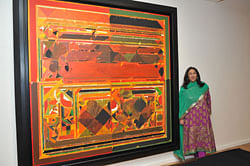
Kher’s seven crore, bindi-studded elephant is only one amongst the list of showstoppers that find place at the 18,000 sq feet museum — Tyeb Mehta’s ‘Falling Bird’, Husain’s ‘Two Women With Elephant’, Raqib Shaw’s ‘The Absence of God’ and Anish Kapoor’s untitled electric blue disc that Nadar had bought during the 2009 edition of India Art Summit.
The Art Summit, in fact, has served its purpose this time as well. The launch of the Delhi museum during the summit days — she had opened the first Kiran Nadar museum within the HCL premises of Noida in January 2010 — was a strategic choice as “foreign galleries, museums and curators were able to visit and offer collaborative ventures for future.”
“Noida is not a very convenient venue for most,” says Nadar, “I wanted the museum to be in a more accessible place where art education, research and exhibition could go hand-in-hand,” says Nadar, who is also a national level bridge player and sports enthusiast.
While her fondness for masters like Souza, Husain and Raza is rather well-known, Nadar has ensured that the art representation in the museum is not tilted towards the progressives alone. Featuring post 1970s’ artists like Rameshwar Broota, K G Subramanyan, J Swaminathan and Jogen Choudhury, the museum also houses works by radical contemporaries like Atul Dodiya, Surendran Nair, Subodh Gupta and T V Santosh, just to name a few.
But what is perhaps the highlight of the museum is S H Raza’s Saurashtra that Nadar bought for a whopping Rs 16.4 crore at a Christie’s auction last year. While the price tag which raised several eyebrows back home is indeed staggering, Nadar refuses to rise to the bait. “I see no reason why the source of my purchase becomes more important than the fact that a masterpiece is now in our country. If it had been available at a place where I could have bought it at half the price, would I have not done so?” she asks.
Indeed, if luck had favoured her, she would have also managed to buy Souza’s iconic ‘Red Curse’ at the same auction for which she ‘underbid’ much to her dismay till date. At the museum, however, Souza’s another work of genius, ‘Crucifixion’, proudly adorns a wall.
Although an impressive array of art, even if it is just a peep into her private collection of over 300 works, Nadar knows that to attract footfalls a lot more needs to be done. “We are in the process of finalising several outreach programmes.”
Hopeful that at least two school visits per week will soon take place, Nadar also shares that the museum director and curator Roobina Karode is drawing up names for regular workshops and dialogue series with senior and younger artists. “It would be interesting to hear a dialogue between someone senior like Rameshwar Broota and the younger A Bala about their treatment of the metaphysical. On the other hand, we hope to invite artists whose practice has been about cityscapes to talk about the influences in their work.”
While luminaries like Sudhir Patwardhan, Ram Kumar and N S Harsha are being considered for such interactive sessions at the museum, Nadar admits that “the task from now on is only uphill”. “While the initial response has been very promising, I want this to be a world class museum,” she says, sharing that the museum will benefit if apart from private patronage, government too gives incentives to those who wish to donate art.
“I got my first painting, a canvas by Ram Kumar, as a donation from Vadehra Art Gallery,” she says, “Arpita Singh donated a large body of her work to the National Gallery of Modern Art and there may be several other artists and patrons who are willing to do the same.”
As of now, Nadar is not the one to wait for someone else’s philanthropy. She has already begun planning another museum in Delhi. While purchases for the same have already begun — she prefers to keep mum at the moment about her new acquisitions — it will be some time before we get to see Nadar’s next dream project and with it, jaw-dropping art!